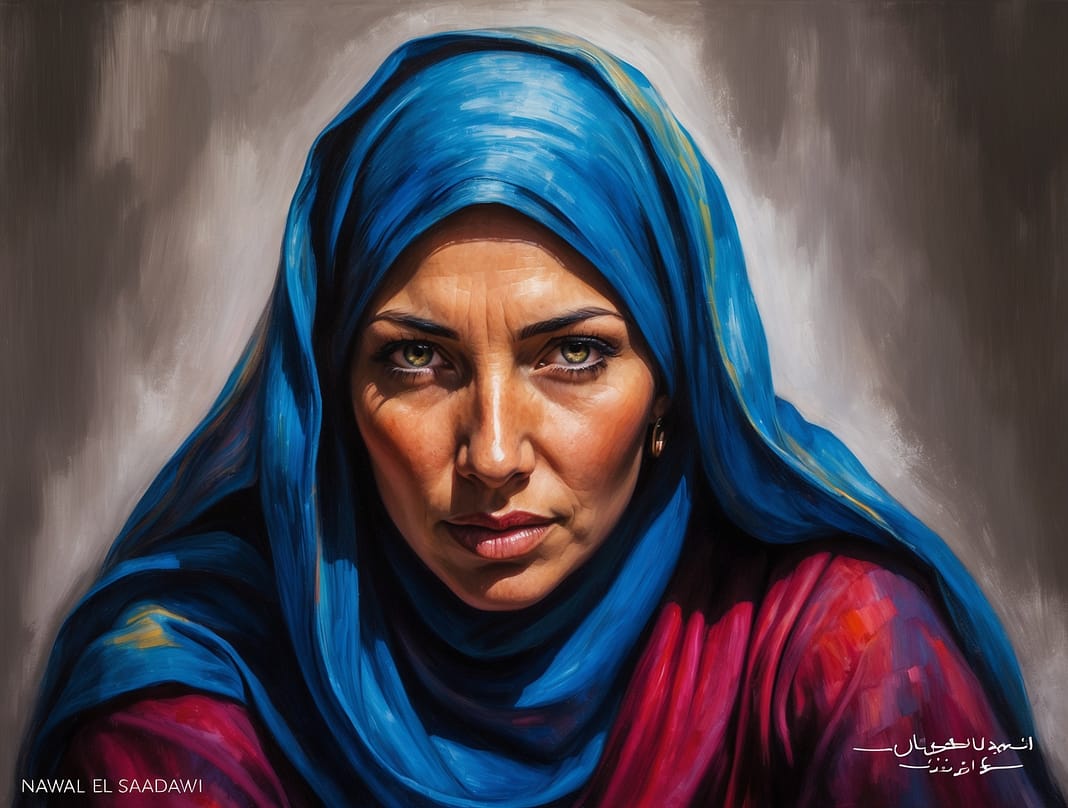There are books that sit quietly on a shelf, waiting to be read, patient as dust settles into their spines. Then there are books like The Hidden Face of Eve by Nawal El Saadawi—books that demand to be spoken about, books that refuse to be silenced. This is not a book you passively consume; it’s a book that consumes you. In the pages of this searing, necessary text, you feel the weight of history, of violence, of patriarchal suffocation so ancient it has woven itself into the bones of a society.
The Hidden Face of Eve is not a typical memoir. It is an excavation, a reckoning, a howl. It is the story of all the women who are erased in the footnotes of history, those left behind to carry the shame of wounds they never asked for. It is a critique—bold and unwavering—of the institutions that bind them to this suffering: patriarchy, religion, colonialism. It is a plea for liberation.
And yet, as one turns its pages, a deep and unshakeable truth emerges—this liberation cannot come without pain.
A Violent Unveiling of Truth
Nawal El Saadawi is not a writer who lets you rest easy. With the precision of a surgeon, she dissects the various ways women in the Arab world are mutilated, silenced, and oppressed. She knows these wounds intimately, having suffered them herself. As a child, she underwent the brutal practice of female genital mutilation (FGM), and as a woman, she faced professional and personal persecution for daring to speak out against the societal structures that perpetuate such violence.
This book forces the reader to sit with the knowledge that oppression is not a distant, abstract concept. It is real, and it is lived in the flesh. Through vivid descriptions, Saadawi paints a visceral portrait of FGM, of arranged marriages, of honor killings, of the many ways women are turned into vessels for shame. In today’s world, where discussions of body autonomy, feminism, and religious freedom are still trending and evolving, The Hidden Face of Eve speaks across decades, calling out to all who dare to listen.
But the book is more than a litany of pain. It is a call to arms. For Saadawi, these traditions are not immutable; they are symptoms of a patriarchal order that can—and must—be dismantled.
A Story Rooted in Defiance
The main character of this narrative, if it can be called that, is not any one woman, but a collective we. It is the “we” of women who have lived under the weight of laws they did not write, who have seen their bodies become battlegrounds for cultural purity. Saadawi writes as both a witness and a participant, speaking for herself and for the countless women whose voices have been stifled. Yet, even as she amplifies these voices, she does not render them as mere victims.
Each story she tells—whether of a young girl enduring the knife of a circumciser or of a mother beaten for bearing a daughter—is imbued with a quiet, rebellious dignity. These women are not static characters in someone else’s narrative. They are breathing, fighting, enduring. They are real, and they demand to be seen.
This is the power of Saadawi’s writing. She does not allow you to look away. The women in this book are not just case studies or symbols; they are fully realized human beings. They have motivations, dreams, and a profound hunger for freedom. And in their hunger, we find the soul of the book: a yearning for a world where women are no longer caged by tradition or punished for their existence.
A Plot Unfolding Like a Slow-burning Fire
The Hidden Face of Eve progresses with the deliberate, measured pace of a slow-burning fire. Saadawi’s prose is patient yet relentless, each chapter adding new layers of understanding, new reasons to be outraged, and new moments of gut-wrenching clarity. The structure of the book is more thematic than linear, allowing Saadawi to weave between personal memoir, historical analysis, and sociopolitical critique. The stories she tells do not follow a straightforward trajectory, but they burn with purpose.
There are no dramatic twists in the conventional sense. The twists come instead in the form of realizations—realizations that oppression is not an aberration but the norm, and that silence is perhaps the greatest violence of all. The pacing allows the reader to sit with these truths, to let them settle uncomfortably under the skin.
The Beauty of Precision in Language
Saadawi’s writing is not indulgent, but it is deeply lyrical. There is a rhythm to her prose, a kind of poetry in the way she combines the starkness of medical precision with the fluidity of her emotional cadence. Her words are sharp, cutting through layers of comfort and complacency, and yet there is a tenderness in her tone, an intimacy in her appeal to readers to bear witness. It is writing that reflects both a deep empathy and a hard-won understanding of cruelty.
Strengths and Shortcomings
The book’s greatest strength is its emotional weight. Few writers can take the rawness of personal and collective trauma and present it with such clarity. Saadawi’s ability to draw connections between personal pain and systemic violence is unparalleled. The book’s originality lies in its unabashed focus on the intersection of gender, religion, and culture within the Arab world, a perspective that was—and remains—underrepresented in global feminist discourse.
But, like all fire, the intensity can sometimes overwhelm. There are moments when the book’s repetitiveness—particularly in its depiction of suffering—can feel almost numbing. Yet this, too, might be part of the book’s design. To truly understand the depth of oppression, perhaps one must sit with it longer than is comfortable.
A Subversive Contribution to Feminist Literature
The Hidden Face of Eve is not content to follow the traditional pathways of feminist literature. It does not present easy solutions or fall into the traps of Western-centric feminist narratives. Instead, it carves out its own space, demanding that we look at feminism not as a monolith but as a movement rooted in cultural specificity and historical context.
In an age where feminist discussions often trend toward the universal, Saadawi reminds us that true liberation must be intersectional, that it must confront not just gender but race, class, religion, and colonialism.
A Deep and Lasting Emotional Impact
The emotional impact of this book cannot be overstated. To read The Hidden Face of Eve is to be confronted with the enormity of suffering that women have endured and continue to endure. It is to feel anger, sorrow, frustration, and, ultimately, hope. Saadawi does not let the reader rest in despair; she insists on the possibility of change, on the necessity of rebellion. The fire she kindles in the reader is one that stays long after the book is closed.
Who Should Read This Book?
This is not a book for the faint of heart. It is for those who are willing to face difficult truths and sit with them. It is for feminists, scholars, and activists who understand that the struggle for women’s rights is far from over, particularly in parts of the world where cultural and religious traditions still bind women’s bodies and voices. It is for anyone who believes that the personal is political, and that storytelling can be an act of revolution.
In the end, The Hidden Face of Eve is a book that defies easy classification, just as it defies silence. It asks us to listen—to stories, to pain, to hope—and, perhaps most importantly, to act.
Recommendations for Similar Reads
If The Hidden Face of Eve resonated with you, here are some other titles that will offer further exploration into the intersection of gender, culture, and liberation:
- “Women at Point Zero” by Nawal El Saadawi: Another powerful narrative by Saadawi that delves deeper into the life of an imprisoned woman and the intersection of gender and justice.
- “The Second Sex” by Simone de Beauvoir: A foundational feminist text that explores the construction of womanhood and the systemic nature of female oppression.
- “We Should All Be Feminists” by Chimamanda Ngozi Adichie: A modern manifesto that expands on global feminism, particularly in the African context.
- “Borderlands/La Frontera: The New Mestiza” by Gloria Anzaldúa: A poetic exploration of identity, culture, and the borderlands between oppressions.
Discover more from The Reasoned Journey
Subscribe to get the latest posts sent to your email.


